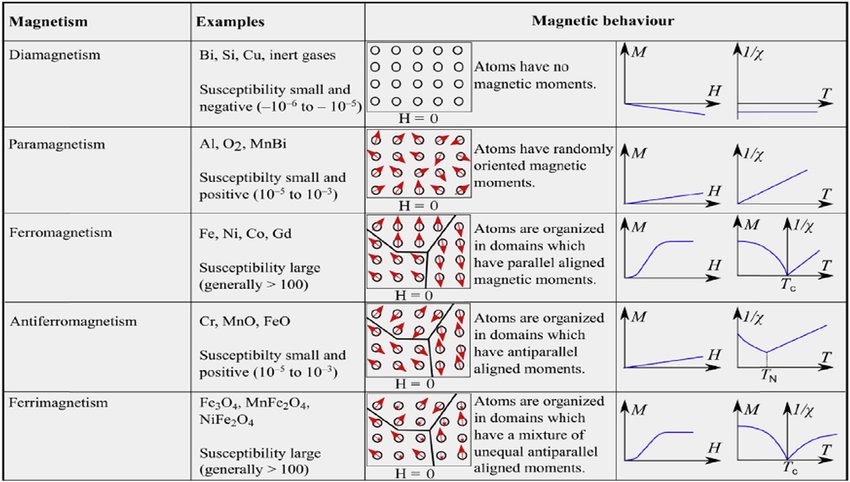Types and Examples of Magnetism
Magnetism is responsible for a wide range of phenomena, from the behavior of magnetic materials to the functioning of everyday devices such as motors, magnets, and MRI machines. The five primary types of magnetism—ferromagnetism, antiferromagnetism, paramagnetism, diamagnetism, and ferrimagnetism—each have unique properties that dictate how they interact with magnetic fields.
Let’s learn about these types of magnetism and how they find uses in theoretical physics and practical applications.

[1]
1. Ferromagnetism
Ferromagnetism is the most well-known and commonly observed type of magnetism. Materials exhibiting ferromagnetism are strongly attracted to magnetic fields and can retain magnetization even after the external magnetic field is removed. This is due to the alignment of the magnetic moments of atoms or ions within the material, which form magnetic domains. In ferromagnetic materials, these domains align in the same direction, producing a strong net magnetic field.
Examples of Ferromagnetic Materials:
- Iron (Fe): Iron is the most common ferromagnetic material, and it exhibits a high degree of magnetization. At room temperature, iron’s magnetic susceptibility is around 2000, and it can reach a saturation magnetization of 2.2 Tesla (T). It is widely used in the production of magnets, transformers, and electric motors.
- Nickel (Ni): Nickel is another ferromagnetic material with a saturation magnetization of approximately 0.57 Tesla. It is commonly used in applications such as batteries, magnetic coatings, and alloy production.
- Cobalt (Co): Cobalt, with a saturation magnetization of 1.4 Tesla, is used in the production of high-performance magnets, such as in the aerospace industry, where strong magnetic properties are essential.
Ferromagnetic materials are crucial in the production of permanent magnets, electric motors, and data storage devices like hard drives. The magnetization of these materials can be influenced by temperature. Above a specific temperature called the Curie temperature (for iron, around 770°C), ferromagnetic materials lose their permanent magnetization and become paramagnetic.
2. Antiferromagnetism
Antiferromagnetism occurs in materials where adjacent magnetic moments align in opposite directions, canceling each other out. This results in no net macroscopic magnetization. However, these materials still respond to external magnetic fields in a way that differentiates them from paramagnetic and diamagnetic materials.
Examples of Antiferromagnetic Materials:
- Manganese Oxide (MnO): Manganese oxide is a classic example of an antiferromagnetic material. Below the Néel temperature (around 122°C for MnO), the magnetic moments of manganese atoms align in opposite directions, leading to zero net magnetization.
- Iron Oxide (FeO): Similarly, iron oxide exhibits antiferromagnetic behavior. The magnetic moments of iron ions in the material align in opposite directions, resulting in no net magnetization under normal conditions.
Antiferromagnetic materials are often used in specialized applications such as magnetic sensors and memory devices, where precise control over magnetic properties is required. Their unique behavior is also critical in the study of spintronics, a field that aims to use electron spin for information processing.
3. Paramagnetism
Paramagnetism is a weak form of magnetism where materials are weakly attracted to magnetic fields. This type of magnetism occurs due to the presence of unpaired electrons in the atomic structure of the material. When an external magnetic field is applied, the magnetic moments of these unpaired electrons align with the field, but the alignment is weak and temporary. When the external magnetic field is removed, the material loses its magnetization.
Examples of Paramagnetic Materials:
- Aluminum (Al): Aluminum is a well-known paramagnetic material. It has a magnetic susceptibility of approximately 2.2 x 10^-5, indicating that its magnetic response is weak. However, it is used in applications such as in MRI (Magnetic Resonance Imaging) machines.
- Platinum (Pt): Platinum is another paramagnetic material, with a magnetic susceptibility of around 1.1 x 10^-5. Its weak magnetic properties make it useful in certain high-temperature applications.
- Magnesium (Mg): Magnesium is a paramagnetic material with a magnetic susceptibility of around 2.5 x 10^-5. It is used in aerospace and electronic applications.
Paramagnetic materials have limited practical uses in comparison to ferromagnetic materials, but they are important in scientific instruments such as thermometers and MRI scanners, where their weak magnetic properties play a role in image formation.
4. Diamagnetism
Diamagnetism is the weakest form of magnetism and is exhibited by all materials to some degree. In diamagnetic materials, electrons respond to an applied magnetic field by creating an induced magnetic moment in the opposite direction. This results in a very weak repulsion from the magnetic field. Unlike paramagnetic and ferromagnetic materials, diamagnetic materials do not have unpaired electrons, and their magnetic behavior is independent of temperature.
Examples of Diamagnetic Materials:
- Bismuth (Bi): Bismuth is one of the most diamagnetic materials, with a very high negative magnetic susceptibility of approximately -1.6 x 10^-4. This strong repulsion is useful in magnetic levitation applications.
- Copper (Cu): Copper is another diamagnetic material, exhibiting weak repulsion to magnetic fields. It has a magnetic susceptibility of around -9.4 x 10^-6.
- Water (H2O): Even water, a non-metallic substance, exhibits diamagnetism. The effect is very weak but noticeable when placed in a strong magnetic field.
Diamagnetic materials are commonly used in levitation experiments, where strong magnetic fields are applied to suspend objects in mid-air, and in magnetic shielding to protect sensitive equipment from external magnetic interference.
5. Ferrimagnetism
Ferrimagnetism is a type of magnetism where the magnetic moments of ions within a material align in opposite directions, similar to antiferromagnetism, but with unequal moments. This leads to a net magnetic moment, making ferrimagnetic materials magnetically active. Ferrimagnetism occurs in materials composed of different types of metal ions, typically iron oxides, where the magnetic moments of different ions cancel each other out partially.
Examples of Ferrimagnetic Materials:
- Magnetite (Fe3O4): Magnetite is one of the most well-known ferrimagnetic materials. It has a saturation magnetization of about 92 Am²/kg and is used in the production of magnetic cores for transformers and inductors.
- Maghemite (γ-Fe2O3): Maghemite is another ferrimagnetic material, which is used in the production of magnetic recording tapes and other data storage devices. Its magnetic properties are weaker than those of magnetite but still significant.
Ferrimagnetic materials are widely used in electronics, particularly in the production of ferrite cores for transformers, inductors, and microwave devices.
Conclusion
Magnetism is crucial in various scientific and industrial fields. The five types—ferromagnetism, antiferromagnetism, paramagnetism, diamagnetism, and ferrimagnetism—differ in how they respond to external magnetic fields. Each type has materials that display specific magnetic behaviors, which are used in applications like data storage, medical imaging, and industrial machinery. For more information, please visit Stanford Magnets.
Reference:
[1] Nisticò, Roberto. (2020). A synthetic guide toward the tailored production of magnetic iron oxide nanoparticles. Boletín de la Sociedad Española de Cerámica y Vidrio. 60. 10.1016/j.bsecv.2020.01.011.














